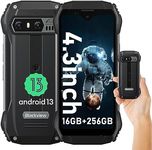We Use CookiesWe use cookies to enhance the security, performance,
functionality and for analytical and promotional activities. By continuing to browse this site you
are agreeing to our privacy policy
Best Mini Smartphones
From leading brands and best sellers available on the web.Buying Guide for the Best Mini Smartphones
Choosing a mini-smartphone is all about finding a device that fits comfortably in your hand and pocket, while still offering the features you need for daily use. Mini-smartphones are great for people who prefer compact devices, want something lightweight, or simply dislike the trend of ever-larger phones. When shopping for a mini-smartphone, it's important to focus on the key specifications that affect usability, performance, and overall experience. Understanding these specs will help you pick a phone that matches your lifestyle and needs.Screen SizeScreen size refers to the diagonal measurement of the phone's display, usually in inches. This is a crucial spec for mini-smartphones because it determines how compact the device will feel in your hand and pocket. Mini-smartphones typically have screens between 4 and 5.5 inches. Smaller screens (around 4 to 4.7 inches) are extremely pocket-friendly and easy to use one-handed, but may feel cramped for watching videos or typing. Slightly larger screens (5 to 5.5 inches) offer a bit more space for content while still being compact. To pick the right size, think about how you use your phone: if you prioritize portability and one-handed use, go smaller; if you want a bit more room for reading or browsing, go for the upper end of the mini range.
Battery LifeBattery life tells you how long the phone can run before needing a recharge. Mini-smartphones often have smaller batteries due to their size, which can mean shorter usage times. Battery capacity is measured in milliampere-hours (mAh), with mini-phones usually ranging from 2000 to 3500 mAh. Lower capacities (2000-2500 mAh) may require more frequent charging, especially if you use your phone heavily. Higher capacities (3000 mAh and above) can last longer, but may make the phone slightly thicker. Consider your daily habits: if you use your phone mostly for calls and texts, a smaller battery may suffice; if you stream music, browse the web, or use apps often, look for a higher capacity.
Performance (Processor and RAM)Performance is determined by the phone's processor (CPU) and memory (RAM). These affect how smoothly the phone runs apps, switches between tasks, and handles updates. Mini-smartphones can have a range of processors, from basic to mid-range. Lower-end processors and 2-3GB RAM are fine for calls, messaging, and light browsing. If you want to play games, multitask, or use demanding apps, look for at least 4GB RAM and a more recent processor. Your choice should depend on what you expect to do: for basic use, modest specs are fine; for more intensive use, prioritize higher performance.
Camera QualityCamera quality is important if you like taking photos or video. Mini-smartphones may not have the most advanced cameras, but you can still find decent options. Look at the megapixel count (MP) for both the main and front cameras, but also consider features like autofocus, image stabilization, and low-light performance. Cameras with 8-12MP are good for casual photos, while 12MP and above offer more detail. If you mostly use your phone for social media or video calls, a basic camera will do; if you want to capture higher-quality images, look for better specs and extra features.
Storage CapacityStorage capacity is the amount of space available for your apps, photos, and files. Mini-smartphones often come with 32GB, 64GB, or 128GB of storage. 32GB is enough for light users who don't install many apps or store lots of media. 64GB is a comfortable middle ground for most people, while 128GB is best if you like to keep lots of photos, videos, or large apps. Some mini-smartphones also support microSD cards for extra storage. Think about your habits: if you use cloud storage or don't keep much on your phone, less storage is fine; if you want everything on your device, go for more.
Build Quality and DurabilityBuild quality refers to how sturdy and well-made the phone feels. Mini-smartphones can be made from plastic, metal, or glass. Plastic is lightweight and less likely to shatter, but may feel less premium. Metal and glass look and feel nicer, but can be more fragile. Some mini-smartphones also offer water and dust resistance, which is useful if you want extra protection. If you tend to drop your phone or use it in tough environments, prioritize durability; if you want a sleek look and feel, you might prefer metal or glass.
Operating System and UpdatesThe operating system (OS) is the software that runs your phone, such as Android or iOS. It's important to consider how up-to-date the OS is and whether the phone will receive future updates. Newer OS versions offer better security, features, and app compatibility. Some mini-smartphones get regular updates, while others may not. If you care about having the latest features and security, look for a phone with a recent OS version and a good track record for updates.


